PMC/PubMed Indexed Articles
Indexed In
- Open J Gate
- Genamics JournalSeek
- Academic Keys
- JournalTOCs
- CiteFactor
- Ulrich's Periodicals Directory
- Access to Global Online Research in Agriculture (AGORA)
- Electronic Journals Library
- Centre for Agriculture and Biosciences International (CABI)
- RefSeek
- Directory of Research Journal Indexing (DRJI)
- Hamdard University
- EBSCO A-Z
- OCLC- WorldCat
- Scholarsteer
- SWB online catalog
- Virtual Library of Biology (vifabio)
- Publons
- Geneva Foundation for Medical Education and Research
- Euro Pub
- Google Scholar
Useful Links
Share This Page
Journal Flyer

Open Access Journals
- Agri and Aquaculture
- Biochemistry
- Bioinformatics & Systems Biology
- Business & Management
- Chemistry
- Clinical Sciences
- Engineering
- Food & Nutrition
- General Science
- Genetics & Molecular Biology
- Immunology & Microbiology
- Medical Sciences
- Neuroscience & Psychology
- Nursing & Health Care
- Pharmaceutical Sciences
Research Article - (2021) Volume 12, Issue 8
Distribution and Status of Maize Common Smut (Ustilago maydis) at West and Kellam Wollega Zones, Ethiopia
Abay Guta* and Urgessa TilahunReceived: 07-Jun-2021 Published: 20-Aug-2021, DOI: 10.35248/2157-7471.21.12.570
Abstract
Maize common smut assessment survey was conducted in the five districts of west and kellem Wollega zones namely Dale Sadi, Gimbi, Haru, Homa and Lalo Kile in 2015 during crop season. Among all cereals, maize is second to teff in area coverage in Ethiopia, but first in productivity and total production. Maize smut was seen as an outbreak at Kellam Wollega although it was not well known so before. Peasant association were randomly selected from each district and based on the representativeness of maize production of the area The locations in each Peasant association were at least 4 km (by car speedometer) apart depend on the topography and the relative importance of maize production. The common smut assessment was made along the two diagonals (in an “X” pattern) of the field from five points using 3 m × 3 m (9 m2) quadrants. Prevalence of maize common smut was 100% in all the districts and the exotic disease species have recently been introduced to the two Zones. This common maize smut was how to introduce not well known. The incidence was ranging from 14.65-22.99% and Incidence of 22.99% was recorded in Dale Sadi, followed by Lalo Kile 20.65%. More than 58.21% of surveyed areas were categorized under low maize common smut incidence which was below 20%. Simple regression analysis was done for disease incidence and severity as response and altitude as predictor variable showed that highly significant (p<0.01) of the overall probability of the equation. The objectives of this study were to determine the prevalence, incidence and severity of maize common smut species in two Zones.
Keywords
Ustilago maydis; Maize common smut; Incidence; Prevalence
Introduction and Background
Maize is the cereal which has had more importance in the economy sector worldwide during all the 20th century and the beginning of the 21st. It is one of the main staple crops that is grown worldwide. Following rice (Oryza sativa L.) and wheat (Triticum aestivum L.), it is the third most important cereal crop in Sub-Saharan Africa [1,2]. Traditionally maize is used for human consumption (white maize) [1] and for animal feed (yellow maize) [2].
In diverse agro climatic conditions, it is one of the most important strategic crops selected for food security mainly due to its high productivity and wider adaptability. Among all cereals, maize is second to teff (Eragrostis tef) in area coverage in Ethiopia, but first in productivity and total production [3]. Maize is currently produced by more farmers than any other crop. According to the agricultural sample survey 2013/14 provided by central statistical agency of Ethiopia, at the national level, there are about 8,809,221.00 maize cropping smallholder farmers.
In mid altitude regions of south, west and North West, maize is normally growing in the main rainy season starting from March to November and depending on maturity groups and onset of rains for each location [4]. Corn is Ethiopia's largest cereal crop in terms of total production, area planted, and number of farm holdings. Maize accounts for 21.16% of the total area covered by cereal and around 30.9% of the total cereal production [5]. In addition to the highest total production per annum and the highest per hectare yield? Maize is also the single most important crop in terms of number of farmers engaged in cultivation [6].
Unknown disease may appear and cause loss. Therefore, regular surveillance for unknown disease and knowledge on the scope and intensity of damage cause by any known disease is crucial. Decade was given to disease survey, loss assessment, screening of maize genotypes against economically important diseases, chemical, cultural and botanical management and study on ear, kernel and stalk rot diseases [7].
Smut (Ustilago maydis) a fungus disease of maize, causes smut masses to form that may be seen on any parts of maize plant roots, stalks, leaves, ears and tassels. The smut masses at the first are covered with white membranes that latter rupture and expose the black sooty spores. These spores carry the fungus over winter and produce secondary spores that may infect the succeeding crops. Infection may take place at any time during the growth of plant [8].
Periodical surveillance to identify the status (severity and prevalence) of economically important crop disease is crucial to decide the damage level and declarer management options. Maize smut was seen as an outbreak at Kellam Wollega although it was not well known so before. Frequent report of maize smut damage was observed from different districts of the administrative zones regardless of cultivars and cropping system used. Economical impact, its prevalence, distribution factors with the current outbreak was not studied and documented. Thus, this survey was initiated with the objectives of assessing the prevalence, incidence and severity of common maize smut at Kellam and West Wollega Zones.
Materials and Methods
Description of the study area
The Field survey was conducted in Western Oromia in west and kellemWollega Zones during 2015 main cropping season. The common smut assessment survey was conducted in the five districts of west and kellem Wollega zones namely Dale Sadi, Gimbi, Haru, Homa and Lalo Kile. In most of the areas, the survey was conducted after duff to maturity growth stages of maize ear. The survey was conducted from 30th September to 8th October 2015. The annual mean minimum and maximum temperature of the area is 12°C and 27.4°C, respectively, while the annual rainfall is 1415.2 mm. The geographical locations of the surveyed areas were located in a range of longitude and latitude of 08°50.124'-09°12.322'N and 035°10.316'-035°54.280'E, respectively (Figure 1).
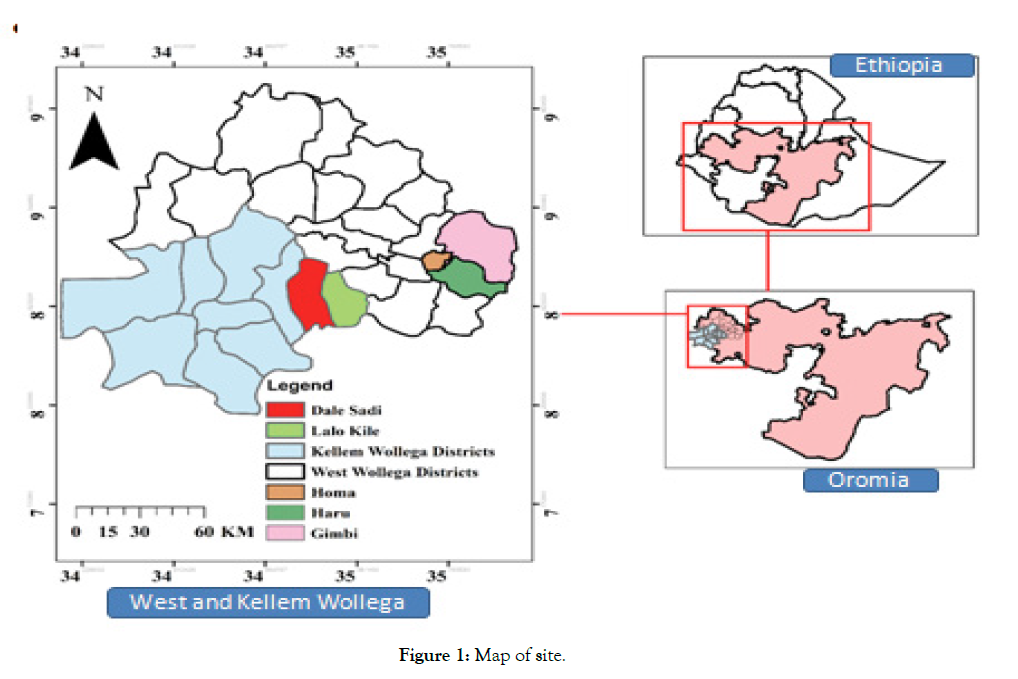
Figure 1: Map of site.
Maize common smut field Survey
Common smut survey was conducted in five districts of West and KellemWollega zones during main seasons of 2015 and common rain distribution season of 2015 in all districts of western Oromia regional state. The five districts had almost near to mid highland (1467-2011 meters above sea level) agro-ecologies. In this area most farms are covered by maize and followed coffee plantation. The survey was conducted in 36 peasant associations (PA) and 67 fields in the five districts of the zones. Stratified sampling technique was applied in the survey. PAs were randomly selected from each district and based on the representativeness of maize production of the area. As a result, PAs were distributed as follow: Gimbi 10 samples, Haru 15 samples, Homa13 samples, Lalo Kile 17 samples and Dale Sadi 12 samples. The locations in each PAs were at least 4 km apart and the distance locations depended on the topography and the relative importance of maize production within each location. The common smut assessment was made along the two diagonals (in an “X” pattern) of the field from five points using 3m x3m (9 m2) quadrates and some questioner rise to farmers. In each field, plants within the quadrates were counted and recorded as diseased/infected and healthy/non-infected and the different parameters were measured as follows. Disease incidence (DI) was the proportion of common smut infected plants to the total number of plants in the quadrate and it is calculated as:

Disease Severity: was expressed as the percentage or proportion of plant area affected by maize common smut disease. More often, disease assessment scales were used to express the relative proportions of affected tissue at a particular point in time. Diseased plants were classified into five classes according to the size of gall in order to have the disease severity expressed as percentage severity index (PSI) as adopted by Johnson and Christensen [9], According to this scale, the actual ear area covered by common smut was estimated. Disease severity was assessed by counting all plants from a single quadrate and added all in five quadrates in single field sample. Finally the average of five quadrate numerical rating was converted to percentage severity index (PSI) using the equation suggested by Wheeler [10] formula

Other independent variables like Altitude of the field in meters were estimated by using GPS. Growth stage of the crop at time of assessment was obtained by visual observation using Zadoks scale. Types of cultivars, Date of planting, Agronomic practices such as number of cultivation, frequency of weeding, fertilizer use were obtained by asking the farmers. All the parameters measured were analyzed by using descriptive statistical analysis over peasant associations, districts and altitude ranges.
Results and Discussion
Importance of maize common smut
A total of 68 fields were surveyed in five districts of West and Kellem Wollega Zones. Disease incidence of maize common smut in the fields was computed for peasant associations, districts and the entire study areas. The indicated analysis shows that maize common smut incidence among peasant associations and districts appeared similar (Tables 1, 2A & 2B). The overall mean incidence at district level was 18.5% within the surveyed areas.
| Scale | Description | |||
|---|---|---|---|---|
| 0 | Very small gall (< 2.5 cm in diameter) | |||
| 1 | Small galls (2.5 to 5 cm in diameter) | |||
| 2.5 | Medium galls (5 to 10 cm in diameter) | |||
| 5 | Big galls (> 10 cm in diameter) | |||
Table 1: Disease rating and description of disease symptom used for assessment of maize common smut diseases.
| Year | Annual mean minimum temperature | Annual mean maximum temperature | Annual mean rain fall |
|---|---|---|---|
| 2006 | 13.2 | 25.5 | 1322.7 |
| 2007 | 13.2 | 25.8 | 1201.5 |
| 2008 | 13.1 | 25.3 | 976.7 |
| 2009 | 13.5 | 25.6 | 1279.3 |
| 2010 | 13.3 | 27.2 | 1421.1 |
| 2011 | 12.8 | 24.8 | 1044.6 |
| 2012 | 13.2 | 25.7 | 1453.9 |
| 2013 | 13.2 | 25.1 | 1795.3 |
| 2014 | 13.1 | 24.6 | 1415.2 |
| 2015 | 12.9 | 25.3 | 1474.4 |
Table 2: Metrology data last ten years (Annual temperature and rain fall).
Disease prevalence
Prevalence of maize common smut was 100% in all the districts (Table 1). This exotic disease species have recently been introduced to the two Zones. The maize common smut is now recognized as a serious problem of maize production in the area, particularly in two Zones (from field interview).This maize common smut was how to introduce not well known because any literature no written the domestication of such disease in the countryIn all the surveyed areas the rainfall distribution was normal distribution and not significant different from previous seven to eight years. The disease outbreak 2013 production year in Dale Sadi, Dale Wabara and Lalo Kile only for the first time and the disease was expanded to other districts in 2014 production year. In surveyed year 2015 almost every districts in the Zones affected (Districts and two Zones office of Agriculture and Ruler development report). Most of farmers not know any information about maize common smut disease and its controlling methods (From interviews).
Disease incidence
The incidence of maize common smut in the fields was estimated for peasant associations (PA), districts and for the entire study area (Tables 3, 4A & 4B). A total of 67 fields were surveyed in five districts of west and kellemWollega zones. The incidence was ranging from 14.65-22.99% and Incidence of 22.99% was recorded in Dale Sadi, followed by Lalo Kile 20.65% (Figure 2). More than 58.21% of surveyed areas were categorized under low maize common smut incidence which was below 20%. At PA level, the highest incidence of 41.2% was recorded in Chole in Dale Sadi district while the lowest incidence of 3.2% was also recorded in KombolchaYonge PA in Haru district About 66.67% of the fields in Dale Sadi district, 60% of the fields in Lalo Kile district, 30% of the fields in Homa district, 26.67% of the fields in Haru District and followed by 20% in Gimbi had incidence greater than 20% (Table 3). This study showed that common maize smut in all the districts was grouped under low incidence category which ranging from 0%-20% (Tables 4A & 4B). The common maize smut incidence of the zones showed that disease was relatively higher in Dale Sadi and Lalo Kile districts, because these districts relatively low land which to cause wormer the Districts than the rest three Districts and the disease have seen for the first time 2013 in these districts. Corn smut was adapted to worm weather. Temperature for spore germination is 26.7-36.1C0 which is considerable higher than for many other smuts [11].
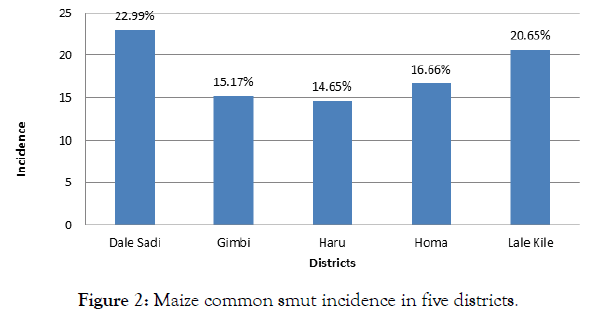
Figure 2: Maize common smut incidence in five districts.
| Districts | Prev. (%) | Inc. (%) | Sev. (%) | Disease Incidence class | Diseases severity class | ||||||||||
|---|---|---|---|---|---|---|---|---|---|---|---|---|---|---|---|
| L | % | M | % | H | % | L | % | M | % | H | % | ||||
| Dale Sadi | 100 | 23 | 23.6 | 4 | 33.3 | 7 | 58.3 | 1 | 8.3 | 4 | 33.3 | 7 | 58.33 | 1 | 8.3 |
| Gimbi | 100 | 15.2 | 17 | 8 | 80 | 2 | 20 | 0 | 0 | 8 | 80 | 2 | 20 | 0 | 0 |
| Haru | 100 | 14.7 | 16.2 | 11 | 73.3 | 4 | 26.7 | 0 | 0 | 11 | 73.3 | 4 | 26.67 | 0 | 0 |
| Homa | 100 | 16.7 | 17.3 | 9 | 69.2 | 4 | 30.8 | 0 | 0 | 8 | 61.5 | 5 | 38.46 | 0 | 0 |
| LaleKile | 100 | 20.7 | 21.7 | 6 | 40 | 9 | 60 | 0 | 0 | 5 | 33.3 | 10 | 66.67 | 0 | 0 |
Table 3: Disease prevalence, incidence and severity of maize common smut in five districts of West and Kellem Wollega Zones.
| Districts | PA | No. of field assessed | Incidence (%) | Severity (%) |
|---|---|---|---|---|
| Dale Sadi | Arere Gabi | 2 | 23.4 | 20.75 |
| Arere Laku | 1 | 31.3 | 32.4 | |
| Arere Ogiyo | 2 | 27.15 | 30.4 | |
| Chole | 4 | 29.78 | 29.43 | |
| Gandaso | 1 | 20.5 | 21.2 | |
| Gonsidaraba | 1 | 13.5 | 14.3 | |
| Hawitu Gandaso | 1 | 15.3 | 16.4 | |
| 22.99 ± 1.56 | 23.55 ± 1.8 | |||
| Lalo Kile | Amarokocho | 2 | 16.4 | 16.9 |
| Bila Bube | 3 | 28.1 | 28.77 | |
| Dagno Dumuga | 1 | 18.8 | 20.7 | |
| Farda Jami | 2 | 19.4 | 20.34 | |
| Jenu | 1 | 11.8 | 13.4 | |
| Lalo Ganda 1 | 1 | 20.3 | 21.7 | |
| Lalo Ganda 2 | 1 | 20.3 | 22.1 | |
| Mangoso Jiru | 1 | 24.5 | 25.4 | |
| Madfo | 2 | 26.5 | 27.4 | |
| Sago | 1 | 28.8 | 26.4 | |
| Odongoru | 1 | 13.4 | 18.5 | |
| Wayu Badas | 1 | 19.5 | 18.6 | |
| 20.65 ± 0.30 | 21.7 ± 0.13 |
Table 4A: Maize common smut incidence and severity in the peasant associations of two districts of Kellem Wollega zone.
| Districts | PA | No. of field assessed | Incidence (%) | Severity (%) |
|---|---|---|---|---|
| Gimbi | Bikiltu Tokuma | 5 | 10.9 | 12.1 |
| Lalisa Iyasus | 4 | 11.01 | 12.2 | |
| LalisaYamsi | 1 | 23.6 | 26.7 | |
| 15.17 ± 3.98 | 17.0 ± 3.31 | |||
| Haru | Chonge | 1 | 28.9 | 30.3 |
| Gadi | 1 | 26.5 | 28.6 | |
| Golja Kata | 1 | 9.2 | 10.1 | |
| Guracho Ujumo | 2 | 8.4 | 9.7 | |
| Guracha Mulata | 1 | 20.2 | 20.4 | |
| Jitu 01 | 1 | 6.2 | 9.7 | |
| Kake Adara | 2 | 15.95 | 17.95 | |
| KobolchaYonge | 4 | 8.08 | 9.1 | |
| Wara Baro | 2 | 8.4 | 10 | |
| 14.65 ± 2.57 | 16.21 ± 2.18 | |||
| Homa | Bonjo Ganji | 1 | 21.4 | 22.2 |
| Gonja Alata | 1 | 12.2 | 15.5 | |
| Homa Birbir | 4 | 21.8 | 18.45 | |
| Sewa Gorgis | 1 | 20.3 | 20.5 | |
| Siba Iyasis | 4 | 11.5 | 12.2 | |
| Siba Matiyos | 2 | 12.75 | 14.7 | |
| 16.66 ±0.22 | 17.26 ±1.06 |
Table 4B: Maize common smut incidence and severity in the peasant associations of three districts of West Wollega zone.
Disease severity
Severity of Maize common smut was recorded and found to vary from low to high at districts and PA levels (Tables 3, 4A & 4B). The highest average severity of 23.55% was recorded in Dale Sadi, followed by average severity of 21.7% at Lalo Kile district, 17.26% in Homa district, 17.0% in Gimbi district and the lowest severity recorded at Haru district. (Figure 3). The lowest severity at Haru district was 16.21%. Severity was below 20% for majority PA’s in Haru, Gimbi and Homa districts. Similarly, severity of the disease majority PA's was between 20% - 40% at Dale Sadi and Lalo Kile districts (Tables 4A & 4B). The overall maize common smut severity mean was 19.0% for the five districts in West and Kellem Wollega zones indicating maize common smut was important in the all surveyed areas. Disease is the most responsible cause for the damage of the maize towards the reduction of yields and quality of productions at all five surveyed area of maize grown (Figure 4).
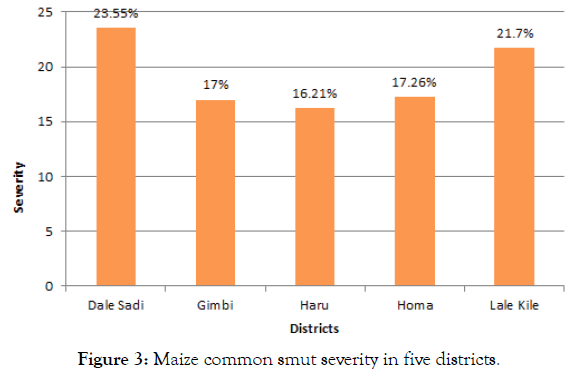
Figure 3: Maize common smut severity in five districts.
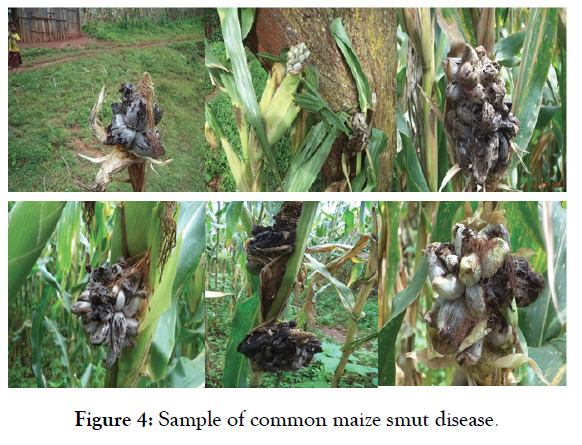
Figure 4: Sample of common maize smut disease.
Cultivars Grown and maize common smut
The growers in the surveyed areas use six different kinds of maize cultivars namely, Agar, BH-543, BH-661,Limu, Local, and Shone. The most widely grown cultivar Shone occupied 36 (53.73%) fields in the surveyed five districts of the zones. Local 19(28.36), BH-543 4(5.97%), Limu 4(5.97%), Agar 2(2.99) and BH-661 2(2.99%) of the surveyed fields (Table 5). Shone was more popular in the two zones but Tircicum leaf blight and gray leaf spot also important issue in the area. However, maize common smut frequency and degree of incidence and severity differ from cultivar to cultivars and field to fields. The study showed that all cultivars were affected. Even thought, different levels of common maize smut incidence and severity was observed on different cultivars grown indicating that some cultivars were less affected by the disease than others; this may need further study to full reason out. But it may be due to the genetic makeup of cultivars which confer difference in resistance under different environmental condition to the maize common smut (Table 5).
| Districts | Cultivar | No. of fields | Incidence (%) | Severity (%) |
|---|---|---|---|---|
| Dale Sadi | BH-661 | 1 | 20.5 | 21.2 |
| Local | 4 | 28.43 | 29.2 | |
| Shone | 7 | 22.92 | 23.74 | |
| Gimbi | Agar | 1 | 4.2 | 5 |
| Limu | 1 | 9.1 | 8.3 | |
| Shone | 8 | 13.6 | 15.48 | |
| Haru | BH-661 | 1 | 10.59 | 9.45 |
| Local | 9 | 14.47 | 16.37 | |
| Shone | 5 | 9.33 | 10.74 | |
| Homa | Agar | 1 | 26.4 | 25.7 |
| BH-543 | 4 | 11 | 11.93 | |
| Limu | 3 | 20.8 | 22.87 | |
| Local | 2 | 18.3 | 18.8 | |
| Shone | 3 | 15.63 | 20.37 | |
| Lalo Kile | Local | 4 | 17.05 | 18.23 |
| Shone | 13 | 23.08 | 22.25 |
Table 5: Maize common smut incidence, severity by cultivars grown in the five districts of West and Kelem Wollega zones.
Altitude and common maize smut
Simple regression analysis was done for disease incidence and severity as response and altitude as predictor variable showed that highly significant (p<0.01) of the overall probability of the equation. For disease incidence and severity the fitted regression equation using a single model revealed that every 100m decrease in altitude at (dough stage) in the surveyed areas resulted increase of incidence and severity by 0.212% and 0.232% respectively. The R-square (r2) value of the equation explained about 21.1% and 17.3% for disease incidence and severity respectively. This is medium probable for disease the surveyed districts of the West and kellem zones. Therefore, the disease needs critical management to save our farmers and environments (Figure 5).
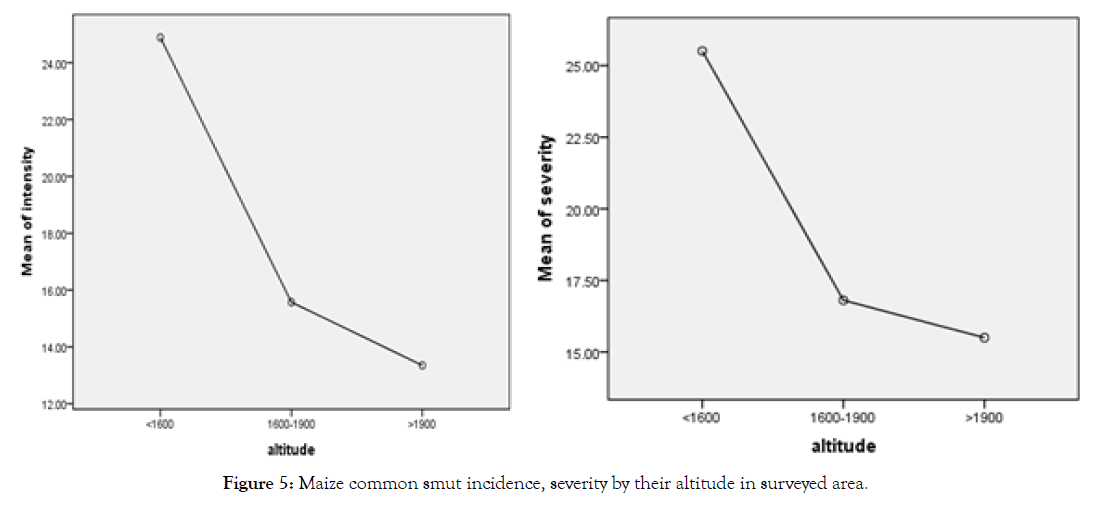
Figure 5: Maize common smut incidence, severity by their altitude in surveyed area.
Conclusion
Results from common maize smut survey in five West and Kelem Wollega zones reveals that common maize smut was prevalent everywhere maize is grown during main rainy seasons with varying degree of incidence and severity. However, the disease prevalence was 100% in all of the surveyed area of the zones that means all surveyed peasant associations in districts were infected. The disease was severe in Dale Sadi and Lalo Kile districts, even though with less than 35% of severity. Most probably in the near future the severity common maize smut may increase because of new disease for new environment. It was for the first time that the disease was identified and recognized by researchers in the surveyed area. Therefore, since disease important it is better doing its management to predict its character and control method. Furthermore, every research institute and stakeholder should pay attention to U. Maydis, before affected livelihood of numerous small-scale farmers.
REFERENCES
- Habib F, Zafar SI. Nutritional changes in maize (Zea mays) during storage at three temperatures. Food Chemistry. 2002;77(2):197-201.
- Dredge RD. Assessment of current economic and physical environment of agriculture. Executive Summary. 2004.
- CSA (Central Statistics Agency). Agricultural Sample Survey 2013/2014 (2006 E.C.). Volume I. Report on Area and Production of Major Crops (Private Peasant Holdings Meher Season). Statistical. 2014.
- CSA (Central Statistical Agency). Report on area and production of major crops (private peasant holdings, Meher Season). Statistical Bulletin. 2010;1 (528):10-14.
- CSA (Central Statistics Agency). Agricultural sampling survey. Report on area and production for major crops. Private peasant holdings (Meher Season) Statical bulletins. 2015.
- Tefera A. Annual report of grain and feed. USDA Foreign Agricultural service. Global Agricultural Information Network. 2013.
- Mosisa WM, Welde L, Wende-Abera D, Birhanu P. Proceeding of the National maize workshop of Ethiopia. 2001.
- Wolfe TK, Kipps MS. Field crop, reprint publication G-432, Nehru Colony, Dehradun, India, 2004.
- Johnson IJ, Christensen JJ. Relation between number, size and location of smut infections to reduction in yield of corn. Phytopathology. 1935;25:223-233.
- Wheeler BEJ. An introduction to plant diseases. Wiley and Sons, London, UK. 1969:374.
- Chester KS. Nature and prevention of plant disease. Jodhpur-India, (2nd edn). 2006.
Citation: Guta A, Tilahun U (2021) Distribution and Status of Maize Common Smut (Ustilago maydis) at West and Kellam Wollega Zones, Ethiopia. J Plant Pathol Microbiol 12:570.
Copyright: © 2021 Guta A, et al. This is an open-access article distributed under the terms of the Creative Commons Attribution License, which permits unrestricted use, distribution, and reproduction in any medium, provided the original author and source are credited.


